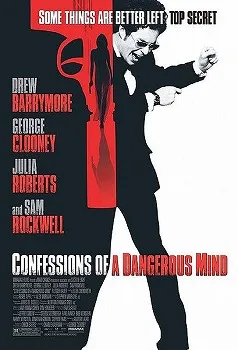Historical accuracy of Confessions of a Dangerous Mind

Historical accuracy of Confessions of a Dangerous Mind

Characters
Chuck Barris (Sam Rockwell)
Based on the real Chuck Barris. His career creating/hosting The Dating Game, The Newlywed Game, The Gong Show is factual. The portrayal of his eccentric personality is accurate. The CIA assassin storyline reflects Barris's claims but is unverified and highly improbable/likely false.
Penny Pacino (Drew Barrymore)
Based on Barris's real-life long-term girlfriend and eventual wife, Penny Pacino. Her loyalty and presence through his tumultuous career are based on reality.
Jim Byrd (George Clooney)
A fictional character representing the CIA figure Barris claimed recruited and managed him for assassination missions. There is no evidence such a person or role existed in Barris's life.
Patricia Watson (Julia Roberts)
A fictional character representing a contact/femme fatale figure within Barris's alleged espionage narrative.
Keeler (Rutger Hauer)
A fictional character, likely representing other agents Barris claimed to have encountered or worked with.
Dick Clark (as himself)
The real Dick Clark appears in interview segments, accurately reflecting his real-life association with Barris (who worked on American Bandstand).
More characters
Jim Lange (as himself)
The real Jim Lange appears in interview segments, accurately reflecting his role as the host of Barris's show The Dating Game.
Jaye P. Morgan (as herself)
The real Jaye P. Morgan appears in interview segments, accurately reflecting her role as a regular panelist on Barris's The Gong Show.
Gene Gene the Dancing Machine (as himself)
The real Eugene Patton appears briefly, accurately recalling his iconic dancing role on The Gong Show.
Story
Barris working at NBC / ABC
Barris did start his career at NBC (as a page) and later worked at ABC, including on Dick Clark's American Bandstand.
Barris writing the song "Palisades Park" (hit for Freddy Cannon)
This is a factual part of Barris's early career before his game show success.
Creation of The Dating Game and The Newlywed Game
Barris factually created and produced these highly successful and influential game shows in the 1960s.
Creation and Hosting of The Gong Show
Barris created and famously hosted the chaotic and controversial amateur talent show The Gong Show in the 1970s.
Barris recruited by CIA / Working as an assassin
This is the central, unverified, and likely fabricated claim from Barris's book, presented by the film as Barris told it. The CIA has denied Barris ever worked for them in any capacity, let alone as an assassin.
Specific assassination missions (Mexico, Berlin, Helsinki etc.)
These events are part of the unverified assassination narrative originating from Barris's book. There is no evidence they occurred.
Using game show chaperone duties as cover for missions
This is integral to Barris's unbelievable claim, linking his real job to his alleged secret one.
Barris's relationship with Penny Pacino
Barris did have a long-term, complex relationship with Penny Pacino, whom he eventually married (though the film simplifies his marital history).
Barris experiencing paranoia / breakdown
Barris did become somewhat reclusive after The Gong Show ended and faced heavy criticism. The film attributes his paranoia primarily to his alleged double life, which is part of the disputed narrative.
Controversy and criticism surrounding The Gong Show
The Gong Show was indeed controversial and often criticized for its perceived low-brow humor and exploitation of contestants, contributing to Barris's complicated public image.
Setting
Television Studios (NBC, ABC - 1960s/70s)
Recreates the look and atmosphere of television production facilities, sets for game shows like The Dating Game and The Gong Show, and backstage environments accurately.
1960s - 1980s American Culture
Captures the changing styles, attitudes, and aesthetics of the eras depicted through costumes, set design, music, and representations of media.
Cold War Espionage Settings
Locations like Mexico City, West Berlin, East Berlin, and Helsinki are presented through a stylized, often noir-influenced lens fitting the fantastical spy narrative, rather than aiming for documentary realism.
Fashion and Style
Costumes accurately reflect the progression of styles from the 1960s through the early 1980s, contrasting Barris's TV persona with the alleged spy world.
Barris's Personal Environments
Settings like Barris's apartments and later house reflect the period and his increasing success (and later isolation).
Blurring Reality and Fantasy
The film's visual style effectively mirrors the ambiguity of Barris's claims, often shifting tones and blending the mundane TV world with stylized espionage scenes.
